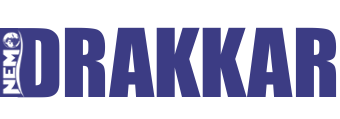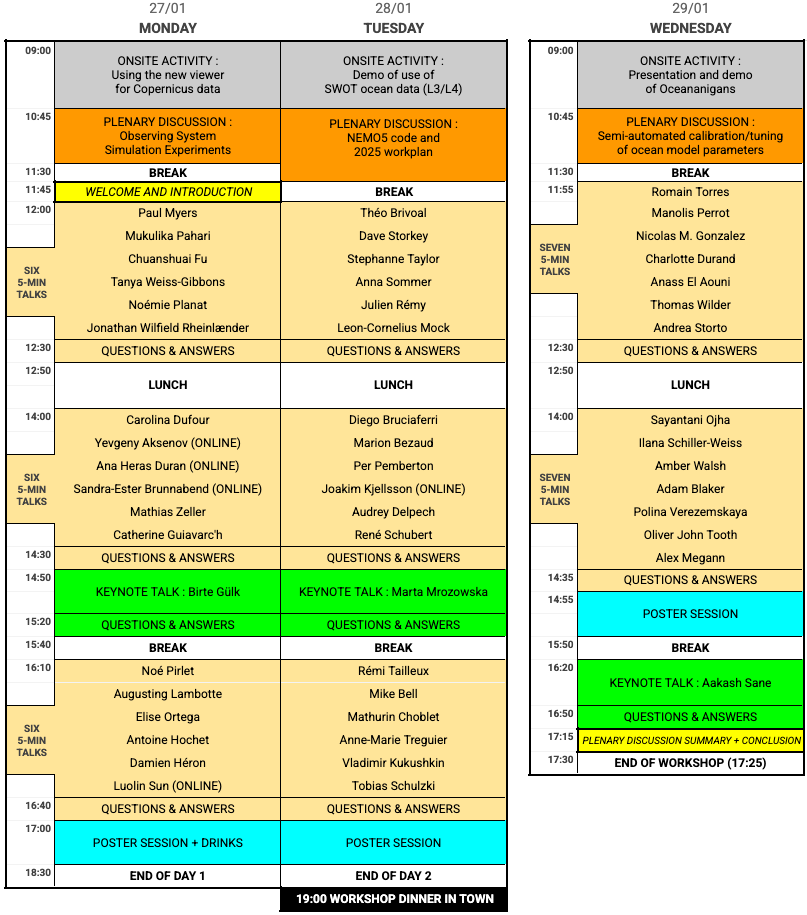|
|
|
Scientific Programme
This tab provides preliminary descriptions of (1) the programme of the workshop, and of (2) the morning sessions. The titles and abstracts of keynote talks will be added soon. (1) PROGRAMME ON-SITE ONLY : Onsite activities, Poster sessions (gray and blue). And meals of course ;) ON-SITE SESSIONS WITH VIDEO ACCESS : All other sessions are accessible here : https://videos.univ-grenoble-alpes.fr/live/events/
(2) MORNING SESSIONS (to be complemented)
ON-SITE ACTIVITY : Demo of viewer and data download toolbox of Copernicus Marine The proposed demonstration of Copernicus Marine tools is split in 2 parts. A first one dedicated to the visualization of the data and a second to the data access. i) Copernicus Marine offers a variety of ocean visualization tools that allow visitors at all different user levels to dive into our digital oceans and explore. Three tools are proposed for: beginner, intermediate and advanced users. During this demo, the advanced users’ tools will be presented (Explore MyOcean Pro). The main objective of this viewer is to let users exploring the Copernicus Marine products available in the Data Store, by displaying the data on a map in 4 dimensions (longitude, latitude, depth and time). ii) The Copernicus Marine Toolbox is a free tool that interoperates with the Copernicus Marine Data Store intending to cover any use case, from retrieval of metadata to a complete dataset, or just a subset, for any type of product: numerical models, satellite and/or in situ observations. Prerequisites before the demo: Required: registration as a Copernicus Marine user (https://data.marine.copernicus.eu/register) Strongly recommended: installation of the toolbox package (https://help.marine.copernicus.eu/en/articles/7970514-copernicus-marine-toolbox-installation)
PLENARY DISCUSSION: Observing System Simulation Experiments (OSSEs) Observing System Simulation Experiments (OSSEs) consist in producing synthetic observations using a numerical model and processing these data for various applications. These applications include, but are not restricted to, the evaluation/optimization of simulations and forecasts, the design/optimization of observational systems, or the interpretation of observational signals. OSSEs are becoming increasingly popular in the oceanographic community and their applications are broadening. This session will propose a quick introduction (15 minutes) of OSSEs followed by a plenary discussion (30 minutes) on potential future developments and applications of OSSEs in the oceanographic community. This introduction will feature three examples of OSSE applications by Pierre Brasseur, Louise Rousselet and Thierry Penduff. The organizers would appreciate to receive your contributions by January 21st through the following link, in order to better prepare the discussion: https://framaforms.org/plenary-discussion-on-osses-2025-drakkar-meeting-1736259893
ON-SITE ACTIVITY : Demonstration of use of SWOT data During this session, we will describe the available ocean data that are being collected by SWOT, the first wide swath altimetry misison. Participants will be guided through two notebooks that will show you how to access and manipulate SWOT ocean data. We will work on data collected during SWOT 1d orbit fast sampling phase, produce animations and compute wavenumber spectra. Participants should bring there laptop, make sure that they have a working internet connection and that they can run jupyter notebooks. Everything is summarized in the repository (https://github.com/drakkar-workshop/drakkar2025-demo-swot-ocean). PLENARY DISCUSSION: NEMO5 code and 2025 workplan In this session, representatives of the NEMO System Team and the NEMO Developer Committee will provide an overview of the main achievements of 2024 and outline plans for the coming year, followed by an open discussion: - NEMO 5 Release Highlights: NEMO 5 and its documentation have been officially released! Alongside various physics improvements, such as the Geometric parameterization for unresolved eddies, NEMO v5.0 delivers significant performance enhancements, enabling configurations to run faster and more cost-effectively than previous versions. It also marks the first steps toward compatibility with hybrid CPU-GPU computing through the integration of PSyclone source-code processing into the build system.
- 2025 Workplan Highlights: Each January, the System Team members and the leaders of each NEMO working groups (HPC, Sea Ice, Kernel, Top, etc.) collaboratively design the work plan for the year. This session will present the key priorities and planned actions for 2025.
- Open Q&A: This session offers an opportunity for users to interact with members of the System Team, ask questions, and share feedbacks.
The organizers would appreciate to receive your contributions by January 21st through the following link, in order to better prepare the discussion: https://docs.google.com/forms/d/e/1FAIpQLSfhsOI8YGz-8rT2hYhYCYuIfTvrCxDTaaRGEE5w0zQHU83FIA/viewform
ON-SITE ACTIVITY : Presentation and demo of Oceananigans Here are some instructions to help you prepare for the Oceananigans session. 1. Installing Julia: Oceananigans and ClimaOcean are Julia-based packages (https://julialang.org/), so you’ll need to have Julia installed on your machine. Installing Julia is straightforward for most systems — you can download the official binaries from https://julialang.org/downloads/ or use juliaup (https://github.com/JuliaLang/juliaup) to have a Julia version manager installed in your system. If you’re using a more exotic machine for which binaries are not provided, you can build Julia from source by cloning the GitHub repository and following the instructions in the README (https://github.com/JuliaLang/julia). Everything is summarized in the repository (https://github.com/drakkar-workshop/drakkar2025-demo-oceananigans). PLENARY DISCUSSION: Semi-automated calibration/tuning of ocean model parameters This plenary discussion will focus the very active field of model calibration and its application to ocean modelling. We will touch upon the available datasets, existing approaches and inherent difficulties of this undertaking. Participants are invited to fill this short questionnaire by Monday 27 January to help us guide the discussion : https://forms.gle/pDAtMYALWSqtBnQL9
(3) KEYNOTE SPEAKERS AND TALKS Three keynote speakers will present their recent work during the workshop. List and abstracts to come.
The Weddell Sea is a region prone to the formation of open-ocean polynyas, offshore openings of sea ice in the winter season. Open-ocean polynyas are often accompanied by deep convection. This makes these polynyas important for the formation of deep waters and allows intense exchange of heat and gasses between the deep ocean and the atmosphere. In the 1970s, large polynyas were observed in the central Weddell Sea. Polynyas of this size and duration have not reopened in the last 50 years. Instead, smaller open-ocean polynyas are irregularly found at Maud Rise, a seamount in the Weddell Sea, for example, in 2016 and 2017. The formation processes of these Maud Rise polynyas are not known with certainty due to sparse amounts of observations and difficulties of models to reproduce the opening and the linked deep convection reasonably well. To investigate the generation of Maud Rise Polynyas we use two regional NEMO configurations with different horizontal resolutions and forced atmosphere. Results of these configurations are compared to available observations and the GLORYS12 reanalysis. Using moderate (1/12º) and high (1/36º) resolution, we find that the interaction of the Weddell Gyre with the Maud Rise seamount preconditions the water column the years before the opening of the Maud Rise Polynyas. Further, we have tested in moderate resolution the impact of numerical choices, such as the surface freshwater forcing and convective mixing schemes. We show that using a convective mixing scheme which parameterizes convection plumes on a subgrid-scale, and allows for thermobaric instabilities, combined with reduced surface freshwater forcing can generate realistic patterns of the polynya events in 2016 and 2017.
Turbulent fluxes across isopycnal layers in the ocean are carried by eddies spanning mere centimeters, and thus cannot be directly simulated in global models. Vertical mixing parameterizations are necessary to approximate the effects of turbulence on the resolved currents. We tune the Turbulent Kinetic Energy (TKE, Gaspar et al. 1990) scheme in the Python ocean model Veros, demonstrating the utility of Bayesian optimization (BO) in ocean and climate model tuning. We present the results of two optimization experiments, TWIN and OBS, both of which target the annual mean mixed layer depth (MLD). In TWIN, the target is a MLD field simulated with Veros using known TKE parameterization. Within 180 model runs, the optimizer identifies a set of parameter values that simulate MLD up to a precision of 1.18%. In OBS, the target is MLD climatology. Across 40 model runs, the default TKE parameterization is among the set of values which minimize MLD bias in Veros. The high default error of 43% is found to originate in the Southern Hemisphere, and none of the values of the TKE parameters tested improve MLD globally. Preliminary results of an extended optimization in a 9-dimensional parameter space show that reducing the MLD bias in Veros requires not only the tuning of the TKE scheme, but also the mesoscale eddy closure and the bulk formula parameters. The strength of the Atlantic Meridional Overturning Circulation (AMOC), Antarctic Circumpolar Current (ACC) and the depth of the 18C isotherm are included as additional optimization targets. In the best simulation, the MLD error is reduced by 30% compared to the default. Additionally, we find that running Veros simulations on Lumi GPUs consumes 17 times less energy than on the DC3 CPU cluster.
The ocean surface boundary layer (OSBL) plays a crucial role in the ocean by modulating the exchange of mass and energy between the atmosphere and ocean interior via vertical turbulent mixing. The processes driving this mixing cannot be resolved in ocean climate models, necessitating the use of numerous ad hoc components for their parameterizations. These ad hoc components contribute to uncertainty in climate projections. In this talk, I will describe improvements in an existing energetics based parameterization of vertical mixing for the OSBL in the NOAA-Geophysical Fluid Dynamics Laboratory’s ocean model (MOM6). I will demonstrate how neural networks, trained to predict the eddy diffusivity profile from a high-fidelity and expensive second moment closure scheme, enhances the vertical mixing scheme in MOM6. These networks replace ad hoc components while maintaining the conservation principles of the standard ocean model equations. This is crucial for their effective use in climate simulations. The enhanced scheme outperforms its predecessor by reducing biases in the mixed-layer depth and modestly improving the tropical upper ocean stratification in ocean-only global simulations. Motivated by the success of neural networks, I will describe how the “black box” neural networks were replaced with interpretable models using equation discovery and empirical fitting techniques. The transparent and interpretable model of eddy diffusivity performs comparably to neural networks, yet at a lower computational cost. Due to its transparency, it also aids in understanding (and fixing) the structural deficiency in the baseline parameterization. This work is one of the first few demonstrations of successfully applying machine learning to target improvements in a sub-grid parameterization of mixing used in ocean climate models. |



